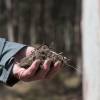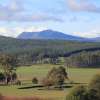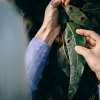
Guidance and support for landowners after damaging winds
Posted 02 September 2024
Tasmania has been experiencing damaging gale force winds resulting in many fallen trees including damage to privately-owned plantations and native forests.
Known in forestry terms as windthrow, trees are uprooted, broken, snapped and overthrown by fierce winds and storms.
Unfortunately, these events are the responsibility of mother nature and can occur in any forested area throughout the world including urban areas and involves extensive clean ups, loss and destruction.
In response to this recent event, Private Forests Tasmania has compiled information for affected landowners and are available to discuss your personal situation further should you require specific advice.
It is important to note the immediate safety evaluation of affected trees within your property, access roads, homes, outbuildings and to livestock. Should you notice unstable trees or down powerlines, please contact the SES immediately on 132 500 or consult a private Tree Arborist to assist with removal of storm affected trees threatening homes and outbuildings.
If your matter is less urgent, you may require the services of a consulting forester who can provide critical technical assistance in all phases of your forest management.
Affected areas should be identified and monitored with appropriate remedial treatment techniques being identified and implemented where necessary.
For example:
1. Edge stabilisation (see below);
2. Re-evaluate the wind risk of the remaining trees and decide to:
- clearfall,
- salvage windthrow or leave the windthrow; or
- if windthrow occurs along a boundary, do not salvage and create a similar new boundary.
3. Retain windthrow as a windfirm buffer or create a new windfirm
Edge Stabilisation
1. Edge feathering will reduce wind-loading on boundary trees. Trees in the edge buffer should be removed in the following order of preference:
- Unsound trees with a large crown, including diseased, deformed, forked, scarred, root rot infested etc.
- Trees with asymmetric or stilt roots.
- Trees on unstable substrates, e.g. rocky knolls, large boulders, poorly drained depressions, etc.
- Tall non-veteran trees, especially with above features or large crowns.
2. Residual trees should be left in the following order of preference:
- Sound, well-rooted veterans.
- Sound trees (strong roots and good taper) with relatively small, open crowns.
- Sound hung-up trees, where safety is not comprised.
3. Stem removal should not exceed 15-20% of the trees in a strip 20-30m from the boundary (not recommended at all in single-story, dense stands).
4. Topping and/or pruning of vulnerable trees may be necessary along boundaries to protect critical areas e.g. reserves, wildlife habitat, etc.
5. 20-30% crown reduction appears to reduce wind risk.
6. Combination of edge-feathering, topping and pruning should be effective in high-risk areas.
Additional information is available on our website including Forest and wind risk in Tasmania – guidelines book and the Wind Risk Calculator tool which is available under our TOOLS tab.
Private Forests Tasmania's Directory of Services also has information on forestry professionals.
Please phone us on 1300 661 009 for any additional information.
Share this Article
Latest Articles
-

20 October 2025
Tasmanian High Soil Carbon Landscapes project
-

17 September 2025
Celebrating excellence at the Tasmanian Timber Awards
-

17 September 2025
Forest Practices Authority Research Update Day
Archives
- ActivAcre hits milestone, calls for more farmers to get on board
- Napier's leading the way in sustainable forestry and carbon-neutral farming
- Sound science needed to assess carbon impacts of timber harvesting
- Newly appointed TFFPN Board of Directors
- Graduate Certificate of Forestry Scholarship
- Forestry Australia Mentoring Program 2025
- Forest Industry Roundtable planning for the long term
- Eagle Management Constraint Period extended
- Successful private native forest management celebrated
- $15 million investment in new ship loader to boost Bell Bay's forestry exports
- Standing with Tasmania's forestry industry: buy local
- TFPA: Tasmanian Freight Equalisation Scheme needs a ground-up review
- AFCA Gala Dinner celebrates industry excellence
- Fire permits now required Statewide
- Forest leaders hone skills in sustainable native regrowth management
- Tasmanian forests and the carbon market: Barriers and opportunities
- What the 2024-25 Tasmanian Budget means for forestry
- Spring is the time for fuel reduction burning
- Primed for Growth: A situation analysis of the Tasmanian Forest and Wood Products Sector
- Audit requirements cut for low-risk plantation projects
- Guidance and support for landowners after damaging winds
- Forestry Australia welcomes further definition of active forest management
- Farm & Forest Mapper Tool highlighted at Rural Youth Tasmania's Young Farmer of the Year competition
- Senate Select Committee inquiry into the Tasmanian Freight Equalisation Scheme
- Timberlink announces new wood composite products brand
- Newly developed protocol a vital tool for safeguarding forestry industry
- Red Hot Tips: Fire management for Tassie farmers
- Bioenergy: Fuelling industries with trees
- Harvesting trees: What you need to know
- Shelterbelts: How are they contributing to farm systems?
- Infill plantings and remnant vegetation: Why biodiversity depends on a thriving understory
- Plantation planning: The key to a successful plantation
- Exciting interactive forestry knowledge hub launched
- $450,000 farm forestry grant recipients revealed


